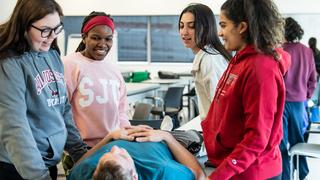Interprofessional Education Prepares Future Health Professionals
Faculty and students at Saint Joseph’s School of Health Professions take a holistic approach to healthcare education and practice.

Caring for a patient requires a team of qualified healthcare providers to work together.
That’s the philosophy for faculty at Saint Joseph’s University’s School of Health Professions, and it informs the curriculum for students studying for future occupational therapy, pharmacy, physical therapy and physician assistant careers.
Interprofessional education occurs when students from two or more professions learn about, from and with each other, according to the World Health Organization. Interprofessional practice in healthcare involves colleagues from different specialties working together to treat a patient.
Both concepts are part of the larger collaborative student learning process, which, for Clinical Associate Professor of Pharmacy Diane Quinn, PharmD, BCACP, is “the wave of the future and the way we should be teaching.”
“We should be innovative, we should think about ways to combine expertise and passions and different disciplines in the way to best help the learning of our students,” Quinn says. “This is really where healthcare is going.”
At Saint Joseph’s, this education pedagogy influences curriculum for these healthcare professional programs, Quinn says. She is excited about future collaboration with incoming Saint Joseph’s programs, including nursing and social work.
And these opportunities involve not only students of different disciplines at Saint Joseph’s, but they also work with aspiring future healthcare professionals at other institutions in the Greater Philadelphia area.
We should think about ways to combine expertise and passions and different disciplines in the way to best help the learning of our students. This is really where healthcare is going.
Diane Quinn, PharmD, BCACP
Clinical Associate Professor of PharmacyAndrew Peterson, PharmD, PhD, professor of pharmacy, recently conducted his first interdisciplinary, interprofessional research study with pharmacy and occupational therapy students. The two sets of students tested the accuracy and ease of a new device intended to dispense medicine from an oral syringe.
“Both sides learned the research process from their perspective and the occupational therapy students saw what the pharmacy students had to learn, and the pharmacy students saw what the OT students had to learn,” Peterson says.
In the field, the University offers several additional opportunities for students to collaborate with their peers in other disciplines both within and outside of the community.
Saint Joseph’s students work at the Cooper Rowan Clinic in Camden, New Jersey, which is housed at Rowan University’s Cooper Medical School, to provide free primary care for uninsured, underserved populations.
Nick Owens, PharmD, BCACP, BCPS, clinical associate professor of pharmacy, supervises pharmacy students who participate in this high-level interprofessional practice opportunity. He says that the more students practice with others in different healthcare disciplines, the more successful they will be in the field.
“I was talking with a student last night who's interviewing for residencies, and he said, ‘Every example I give is an example from the clinic where I did something that most other students have never had the opportunity to do,’” Owens says.
Julia McGoohan, a Doctor of Pharmacy candidate, works at the Cooper Rowan Clinic, where she says pharmacy students go over patients’ medication lists with them and ask about medication concerns, while medical students complete a typical assessment and exam. Afterward, the two come together to determine the best course of action for the patient, under the supervision of pharmacist and physician preceptors.
“Working with other disciplines has allowed me to get a sense of the roles and responsibilities of other healthcare professionals, as well as an appreciation of the impact they have,” McGoohan says. “In the future, I would love to work in a collaborative care environment. I probably would not have known that existed without my experiences that I have had here as a pharmacy student.”
Another opportunity for aspiring healthcare professionals to work together is at the University’s pro bono clinic in University City, which offers free physical therapy and occupational therapy services.
Advised by Clinical Assistant Professor of Physical Therapy Shaun Varrecchia, DPT, the clinic and interprofessional education, in general, introduce students to working with other healthcare professionals, a typically intimidating moment, he says.
“Especially when you're a newer clinician, once you recognize that something's not going as it should be with your patient, you kind of know in the back of your head, ‘I need to call the physician,’” Varrecchia says. “Introducing students to the other professionals earlier is very important to tear down that barrier and say, no, these are clinicians who have had similar experiences and their education just like yours, you speak the same language, you understand the same things.”
For McGoohan, who is scheduled to graduate in 2025, her education experiences have taught her to care for the whole patient, she says.
“Healthcare should be multidisciplinary so the patient can get the best care possible,” she says. “While healthcare students have similar or overlapping courses, they are also different, which allows for other perspectives and knowledge.”
